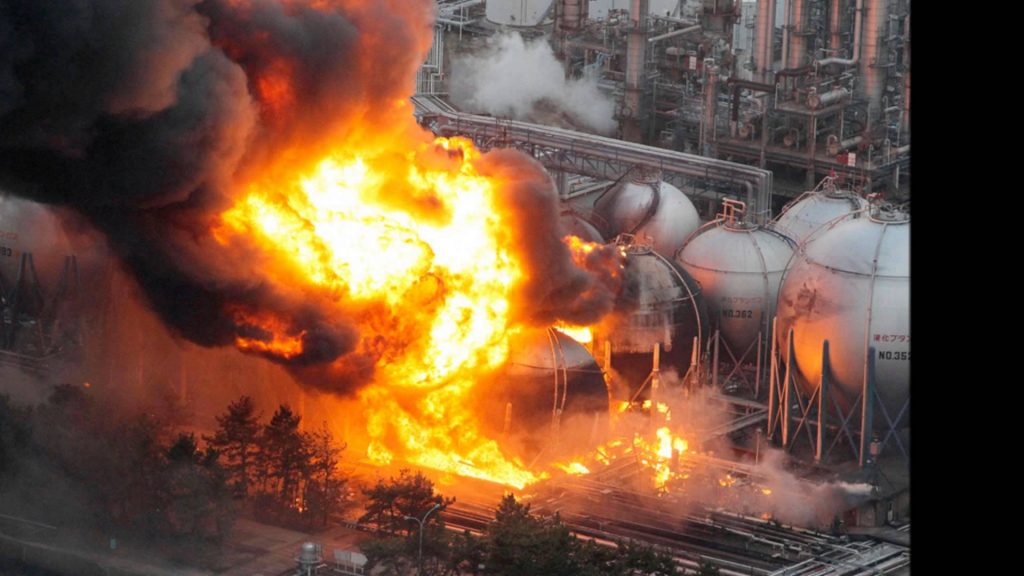Natural disasters are very common but tragic events around the world. From earthquakes to tornadoes, geological disasters can cause increasingly damaging effects, affecting the landscape and those who find themselves there. But when these events are combined with man-made artifacts, the effects might be even greater. An example of this is the Fukushima Disaster in Japan, the worst nuclear disaster since the 1986 Chernobyl incident.1 But the cause of this horrific disaster wasn’t particularly a man-made event. In fact, it all started with a wave.

On March 11, 2011, an earthquake with a magnitude 9.0—the worst to ever hit Japan—hit the country. It was such a powerful catastrophe, that Japan’s main island, Honshu, was permanently moved more than two meters to the east. As the earthquake gained momentum, waves up to 40 meters began crushing the country’s coast. The effects of the earthquake and the waves were too much for the Japanese. More than 20,000 people died or went missing and hundreds of thousands more lost their homes.2 But the worst was yet to come. Fifty minutes after the initial earthquake, a ten-meter high sea wall hit the Fukushima Daiichi (Number One) nuclear power plant. The water flooded the plant’s emergency power generators, knocking vital cooling systems offline, triggering a meltdown of reactor fuel rods. These then leaked deadly radiation into the coastal atmosphere of Japan. With the cooling systems not working, hydrogen gas built up in the reactor buildings, causing several hydrogen explosions in the following days of the earthquake.3

Because of the highly toxic radioactive material that leaked to the surrounding areas of the power plant, the government began to evacuate 80,000 people from a twelve-mile radius. Technicians turned to several things to try to cool the nuclear fuel, like using fresh water, seawater, and injecting nitrogen into the reactor containment buildings to prevent further explosions.4 But despite the efforts to try to help the people of Honshu, the government didn’t tell the people the truth. The official statistics of the event and even the admittance that the meltdown had taken place weren’t disclosed until eighty-eight days later.5
It was estimated that more than 800,000 tons of highly-radioactive material sat near the accident, which was slowly getting into the ground and moving towards the ocean. Although many people were evacuated, there were still many that couldn’t leave. The government installed temporary housing that was intended to house tens of thousands of people after the disaster for twenty-four months. But five years after the disaster, thousands of people were still living where they were surrounded by the radioactive material. Many of those who remained were the elderly and low-income families who had few options to move away.6

Several months after the disaster, people in other parts of Japan began rallying to help these people and bring an end to nuclear power plants in Japan. This pushed forward for the closure of all of the other nuclear plants in Japan for maintenance and inspection.7 These protests also pressured the government to issue a report on the disaster at Fukushima. This report criticized TEPCO (the Tokyo Electric and Power Company) for failing to address concerns about safeguards at the plant. This report also included information about how TEPCO officials had ignored engineers’ concerns that a seawall constructed to protect against major tsunamis as they had seen on March 11 was not sufficient. The report additionally criticized safety regulators for not implementing proper safety measures and for failing to adopt global nuclear safety standards.8 This was really important for the Japanese because TEPCO had always emphasized that the nuclear generators were “fail-safe,” that the facility was completely earthquake resistant and that the reactors would be able to withstand a major tremor.9
Five years after the disaster in Japan, several policies were changed to address the rising concerns of the Japanese population regarding nuclear power plants. The major decision of this kind was the decision to phase-out nuclear power plants during the 2030s as part of Innovative Strategy for Energy and the Environment adopted by the cabinet of the Democratic Party of Japan (DPJ).10 TEPCO is still facing criticism regarding the amount of nuclear material that was leaked into the environment and it is estimated that cleanup operations could take up to forty years.11
- Will Ripley, Junko Ogura, and James Griffiths, “Fukushima: Five Years after Japan’s Worst Nuclear Disaster,” CNN, March 11, 2016, sec. World. ↵
- Encyclopedia Britannica, 2018, s.v. “Fukushima Accident.” ↵
- New World Encyclopedia, 2017, s.v. “Fukushima nuclear disaster.” ↵
- New World Encyclopedia, 2017, s.v. “Fukushima nuclear disaster.” ↵
- Will Ripley, Junko Ogura, and James Griffiths, “Fukushima: Five Years after Japan’s Worst Nuclear Disaster,” CNN, March 11, 2016, sec. World. ↵
- Will Ripley, Junko Ogura, and James Griffiths, “Fukushima: Five Years after Japan’s Worst Nuclear Disaster,” CNN, March 11, 2016, sec. World. ↵
- New World Encyclopedia, 2017, s.v. “Fukushima nuclear disaster,” ↵
- Encyclopedia Britannica, 2018, s.v. “Fukushima Accident.” ↵
- Akira Nakamura and Masao Kikuchi. “What We Know, and What We Have Not Yet Learned: Triple Disasters and the Fukushima Nuclear Fiasco in Japan,” Public Administration Review 71, no. 6 (2011): 894. ↵
- Rie Watanabe, “After the Fukushima Disaster: Japan’s Nuclear Policy Change from 2011 to 2012,” Review Of Policy Research 33, no. 6 (2016): 623. ↵
- Alexis Dudden, “The Ongoing Disaster,” The Journal of Asian Studies 71, no. 2 (2012): 349. ↵




111 comments
Tyler Boyd
Well written article which did a very good job of pointing out what happened and who was responsible. I would disagree with you on one point, this didn’t start with a wave it started as soon as TEPCO decided not to listen to its engineers. If they were told by their experts that the sea wall was insufficient then it is my opinion that they are 100% responsible for what happened. Sadly, I don’t think they will be held accountable for their gross negligence and the only ones who will pay are the low income and elderly population of Fukushima which the article pointed out.
Alexandra Berrones
I am a big Environmental friendly person. I strongly agree that power plants are very dangerous to our environment. This incident reminds me of the Love Canal that greatly impacted hundreds of families, innocent people who didn’t know they were living in an environment polluted caused from a landfill. The government of Japan should’ve understood from the US mistakes and made sure that they had everything prepared for such a big incident that affects many people.
Daniela Duran
It is always impressive to read about how damaging a natural disaster can be, but when it involves human mistakes and man-made disasters, the situation gets even worse. I studied nuclear plants back at high school and knowing how dangerous they can be, I agree with the Japanese in that the company should have taken greater safety measures around it. I personally consider that it is a form of social dishonesty from the company, to claim that the plant is safe, only to later discredit themselves with such a terrible indecent. I also think that the government’s dishonesty when they hid the incident form the people was very inappropriate, and, as a matter of fact, this was just as bad as the company not taking the adequate safety measures. perhaps more people would have been affected by radiation (if they did get affected at all) inf the government had spoken beforehand. I really liked the style of written in this article, for it made it interesting, dramatic, and it simultaneously made it seem as a criticism on the importance of safety measures. The choice of images and even the title made the entire reading more enjoyable and dramatic.
Honoka Sasahara
This article is sophisticated and reserched well.
I’m from Japan and experienced the disaster. Although my area was far from Fukushima and coast areas, I remember it was so frightening.
Still now, many people are forced to live uncomfortable lives and remonstrate with the government on operation of nuclear power plants but they keep working as before.
I’m so glad to hear people abroad know and talk about this because it may lead to change of the condition. Thank you.
Kristy Feather
Even though we as a people didn’t cause the tsunami, we can not deny that we are single handedly responsible for the damage and destruction that occurs because of them. We know that mother nature can not be controlled and we know that she is powerful and yet we still erect man-made structures for her to break down, causing more destruction. As children we are taught not to do something again when our mom’s spank us, her emother nature is doing that to us and yet we just repeatedly brush her off and continue to do what we want as if she won’t turn around and tear down everything else. It’s fascinating how intelligently dumb humanity is. This article perfectly highlights the idea that we should be asking ourselves “Should we” instead of “Can we”.
Jorge Martinez
This series of unfortunate events is why every concern when constructing any type of building should be addressed. I honestly find it quite ridiculous the TEPCO tried to avoid such precautions when constructing this power plant. This is a building where if any type of break out were to happen, the ecosystem would be altered forever. Radiation is a beneficial but risky source of power and it should be dealt with care.
Maggie Amador
This disaster highlights how mankind lacks in ensuring the safety of others pre and post-disaster. I understand that one cannot guarantee safety without the proper test, and I’m sure TEPCO did what they thought was the best safety measures for the average natural disaster in Japan but I believe there was more that could have been done. For example, the company claimed the generators were “fail-safe” yet the generators failed which means that they were not up to par with global standards from the beginning. Also, the idea that many of the lower class citizens were forced to live in dangerous conditions for five years is mind-blowing. Hopefully, in the near future, there will be a way not only to rush the cleanup process but also to guarantee a disaster like this will never happen again.
Taylor Rech
This article explained how a natural event can destroy what mankind has created, wiping out buildings as well as wrecking the communities by killing people, while also shedding light on the issue of nuclear energy. I really enjoyed how this article pointed out a serious issue for the environment without simply throwing blame out, but rather by providing facts. The damage that can be done by tsunamis is one that everyone knows, but this article emphasized the long-term effects of this damage when deadly materials are involved which causes readers to contemplate the development of society. Readers begin to wonder if something as unpredictable as a tsunami can cause this much trouble, why are we as humans helping to worsen the damage by using an energy source that is harmful to ourselves and our environment without ensuring that it can be safely contained in the case of disasters.
William Ward
One again, history repeats itself. Even though the circumstances were different from the awful Ukrainian nuclear reactor disaster, this event seems to be Chernobyl all over again. It took 573 deaths to convince the Japanese government these plants are a danger. These reactors have wonderful intent but occasionally possess terrible consequences to the surrounding people. Perhaps if other governments decide to build reactors of their own, they will follow the designs of nuclear plants here in the USA which have different and more restrictive designs to ensure events like Chernobyl and Fukushima do not reoccur.
Robert Freise
It is unimaginable what the combined power of a natural disaster and a man made structure can have on a part of civilization. This disaster was the modern day Chernobyl. It is terrible that many people that were unable to afford to move out of the disaster zone by reactor number one. The side effects of radiation had to be tremendously bad for their health and future generations health as well. This article helped me understand more about the disaster. It gave me the insight of the politics involved with TEPCO and how even if they issued that the reactors were totally earthquake resistant, mother nature proved otherwise and created mass destruction for the Japanese people. This article really helped understand more deeply about the effects of Fukushima.